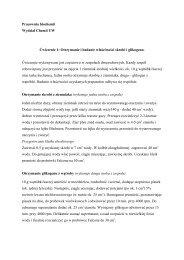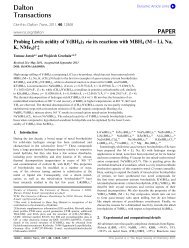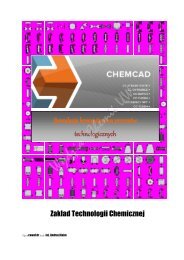Chem. Anal. (Warsaw), 53, 759
Chem. Anal. (Warsaw), 53, 759
Chem. Anal. (Warsaw), 53, 759
You also want an ePaper? Increase the reach of your titles
YUMPU automatically turns print PDFs into web optimized ePapers that Google loves.
780 Z. Hubicki, M. Wawrzkiewicz and A. Wo³owicz<br />
ture produced by Mitsubishi Co. Ltd. were investigated, too. Au(III), Pd(II) and Pt(IV)<br />
ions were eluted with 0.1 mol L –1 NH 2 CSNH 2 solution in ethyl alcohol at 100% yield.<br />
Figure 24. Structural formulas of Diaion WA–20 and Diaion WA–30<br />
Amberlite IRA–93 is a weakly basic macroporous anion exchanger with functional<br />
dimethylamine groups and polystyrene–divinylbenzene matrix used in recovery<br />
of noble metal ions from the used automobile catalytic converters (Fig. 25).<br />
Rh(III) was desorbed from the anion exchanger bed as the first with 6 mol L –1 HCl<br />
solution, while Pd(II) was eluted with 1% ammonia solution at the room temperatures.<br />
Pt(II) was eluted using 5% ammonia solution at elevated temperature. Separation<br />
of palladium from platinum can be achieved by reduction of Pd ions to the metallic<br />
state, or by precipitation of (NH 4 ) 2 PdCl 4 and (NH 4 ) 2 PtCl 6 with HCl solution. The<br />
presented ion exchange method with Amberlite IRA–93 for selective separation of<br />
palladium, platinum, and rhodium from acidic solutions obtained by leaching honeycomb-type<br />
catalytic converters can be regarded as the efficient technique for separation<br />
of these metals on the analytical scale and could be applied for large scale operations.<br />
Noteworthy, owing to nontoxicity, nonvolatility and nonflammability of the<br />
Amberlite IRA–93 resin, this method might be accompanied by fewer environmental<br />
hazards than the currently adopted solvent extraction and precipitation techniques<br />
[75].







